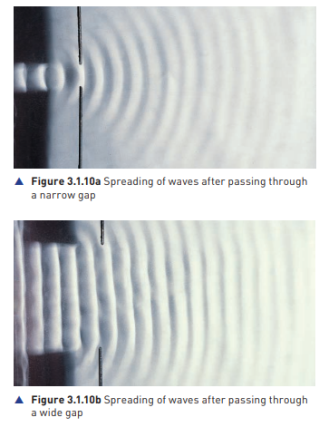WAVES (EDEXCEL)
Waves transfer energy without transferring matter from a point to another.
When light waves pass from a phone to your eye, only energy is being transferred.
In water waves, it's the wave that travels and not water itself.
Direction of propagation: direction in which the wave is moving or travelling.
Mechanical Waves:
Need a medium to travel from a point to another.
Can't travel in vacuum.
E.g. sound waves, sea waves, seismic waves, waves in a rope or spring.
All of these require a medium to travel. Sound cannot travel without air, sea waves cannot travel without water.
Electromagnetic waves:
Don't need a medium to travel.
Can travel in vacuum and through a medium too.
E.g. gamma and X-rays, UV rays, visible light, infrared, microwaves, radio waves.
TYPES OF WAVE MOTION
Transverse waves:
The direction of vibration (of the source or the medium's particles) is at right angles to the direction of wave motion.
High points are called crests, and the low points are troughs.
E.g. EM waves, water waves, waves in a rope, seismic S-waves.
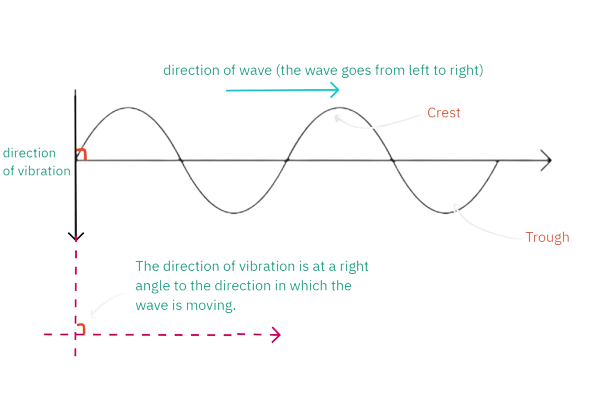
Longitudinal waves:
The direction of vibration (of the source or the medium's particles) is parallel to the direction of wave motion.
E.g. sound.
Particles of the source move back and forth along the same line in which the wave is travelling.
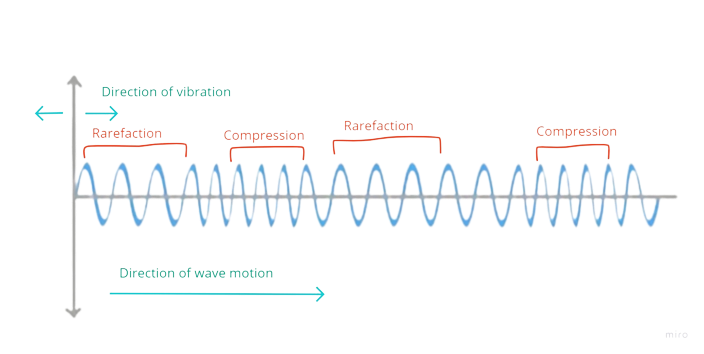
Compression and rarefaction:
Compression: particles are closest together (high pressure zone).
Rarefaction: particles are furthest apart (low pressure zone).
Particles do not move along with the wave, they only oscillate up and down their individual positions.
Animations in this link will help understand this:
https://www.acs.psu.edu/drussell/demos/waves/wavemotion.html
FEATURES OF A WAVE
Amplitude (A):
The height of a crest or the depth of a trough is amplitude.
The maximum displacement of a point on a wave from its mean position.
The maximum and minimum points of amplitude are same, there's only difference of signs, e.g. +8 and -8.
Measured in metres (m).
Larger the amplitude, the more the wave's energy.
Time period (T):
Time taken to produce one complete wave/oscillation.
Frequency (f):
The number of waves passing a point per second (or produced per second) is frequency.
Measured in Hertz (Hz).
Frequency = 1/T, where T is the time period.
Higher the frequency of a wave, smaller its wavelength.
Wavelength (λ):
The length of one complete wave is wavelength.
It's also the distance between two **consecutive** crests or troughs.
Wave speed (v):
The distance travelled by a waveform per unit time.
Wave speed = wavelength x frequency.
Measured in m/s.
Phase:
Two points are in phase if they have the same displacement and motion throughout the wave motion.
Points 1 wavelength apart are always in phase.
In this displacement-distance graph, points B and D have the same motion and displacement, so they are in phase. A and C are in phase too for the same reason. They have the same speed* in the same direction. Points B and D are not in phase with points A and C, however, because their directions of vibration are opposite.
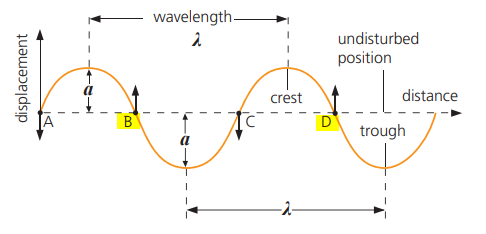
Wavefront:
An imaginary line that joins all crests or troughs of waves travelling parallel to one another.
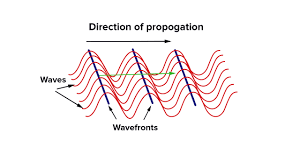
Reflection at a plane surface:
Reflection: the change in direction of a wave as it collides with an obstacle.
During reflection, frequency, wave speed and wavelength don't change.
The amplitude decreases after reflection due to loss of energy.
Larger the amplitude, more the wave's energy.
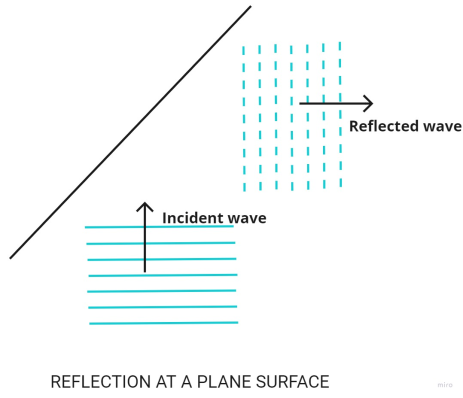
Drawing reflection:
The normal is an imaginary, dotted line that is at a 90 degree angle to the surface.
The incident wave is that which is approaching.
The reflected wave is the wave that's reflected.
Method:
Draw a normal line to the points where wave fronts strike the barriers (make sure it's dotted).
Note the angle between the incident wave and the normal (i.e angle of incidence).
Draw a reflected wave on the opposite side of the normal at the same angle.
The length of the reflected wave should be according to the size of the portion reflected from the barrier.
Make sure that the reflected waves are parallel to one another.
Refraction:
Refraction is the change in wave speed and wavelength as the wave travels from a medium to another, or from one depth to another.
For electromagnetic waves, refraction is when the EM waves slow down or speed up due to the change in medium of the wave in which it travels.
For water waves, when a wave travels from deep to shallow water, the wave speed and wavelength decrease.
Depth decreases, so wavelength decrease and so does the wave speed and vice versa.
Wavelength and wave speed are directly proportional.
If the change in depth is perpendicular to the direction of approaching waves, wavelength and wave speed will change and not direction.
If the depth of water is changed at an angle, the direction of the waves also changes along with the speed.
Unless the source of vibration changes, the frequency remains unchanged.
Diffraction:
When waves meet a barrier, they pass through the gap and spread out.
The spreading of waves at the edges of obstacles is diffraction.
The way the waves diffract depends upon how big the gap is.
The wave spreads out more if the gap is made narrower or if the wavelength is increased.
It spreads out less with a wider gap or a shorter wavelength.
